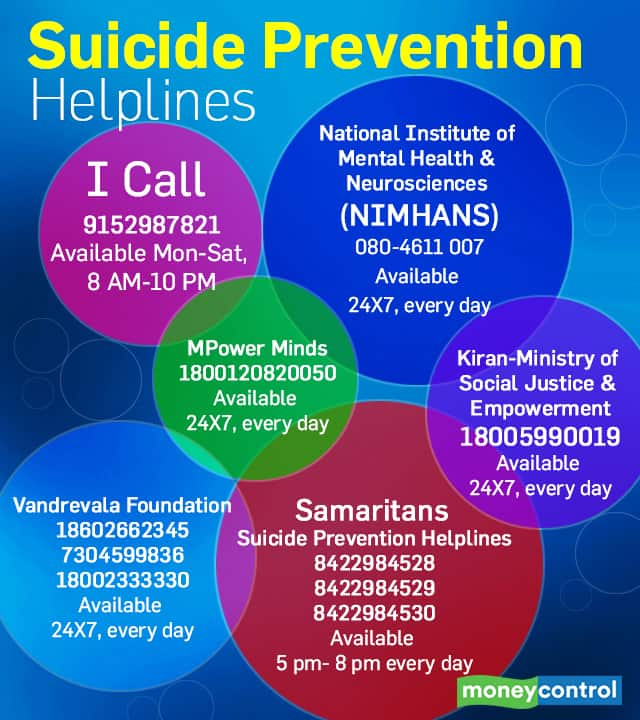



National Crime Records Bureau (NCRB) data show that 11,396 children died by suicide in 2020, up from 9,613 in 2019 and 9,413 in 2018. Experts said that school closure and the resulting social isolation and Covid anxiety among adults exacerbated the problem in a pandemic year.
Suicide rates were also up among daily wage earners, businesspersons, and those in the farm sector. More than 1.5 lakh people died by suicide across India in 2020.
World Health Organization (WHO) data show that more than 7 lakh people die each year by suicide. Further, according to WHO, "suicide is preventable".
There are many resources available on suicide prevention. Case in point: a recent report by the Mariwala Health Initiative (MHI) titled ‘Suicide Prevention: Changing the narrative’. The report presents data and offers ideas on how to create a space for conversations on suicide prevention and possible solutions.
Below are ways and means that experts suggest for preventing suicide:
Causes and risk factorsIf we look at Western countries and India, there is a difference in the causes and underlying reasons for suicide. In India, suicide may not necessarily be linked to mental illness. The NCRB report suggests that suicide in India is often linked to family conflicts, unrealistic societal expectations, academic performance, unemployment, and poverty, etc.
Dr Aparna Joshi, project leader of the Psychosocial Helpline iCall, says that while suicide in men is linked to "issues pertaining to their (feelings of) failure to perform as a man, a provider", the causes of suicide in women are often linked to relationship issues, such as conflict in the family or marital problems, or abuse.
What you can do to prevent suicideExperts say that suicide prevention requires both an individual and community approach:
Engage in self-care activities: Don't limit self-care to when there is a crisis. Engage in self-care activities using the resource available to you. Singing, going for a walk, painting, etc., whatever helps you take care of you.
Seek help sooner rather than later: Sign up for therapy or call a helpline. These are signs of strength and not cowardice. And it is better to do so earlier than later when the case may become complicated.
Understand what you can and cannot control: One needs to understand and accept that some situations can be controlled and changed and some can’t.
Celebrate small victories: Look at how far you have come and celebrate the small wins on a regular basis.
Be compassionate: Be kind, and understand that you live with people around you. As much as possible, have equal division of work and responsibilities in relationships and families. Show empathy and care to others around you. Check in regularly with friends, relatives and colleagues to make sure they are alright.
Community measuresHave an intersectoral approach: Create safe communities, employment opportunities, and educational opportunities. While suicide is everyone’s issue, data shows that certain groups and communities are far more vulnerable than the others.
Life skills as a part of formal education: Our conditioning at a young age determines how we respond to situations as adults. Life skills will teach children how to deal with problems and crises in their lives constructively.
Change the narrative of suicide reporting: Dr Nitesh Dave, managing trustee of the suicide prevention helpline Mitram Foundation, says: “Most people who once thought about killing themselves are now glad to be alive. They say they didn't want to end their lives - they just wanted to stop the pain. Glorifying suicide is not the right way to portray it, and media needs to change that so that people don’t perceive it in that manner. We need responsible media reporting that focuses on not sensationalising suicide but works to emphasise resources, and coping.”
Funding support: Manohar Rangnekar, deputy director of suicide prevention helpline Samaritans Mumbai, says that research has shown a direct reverse correlation between suicide ideation with care given. “Hence involvement of the community to have conversations, as well as work together to distance the lethal means from the distressed is important. Community involvement plays a big role. With funding, caregivers can conduct follow-ups, outreach, gatekeeper training, etc., We as a society can prepare and educate family and community,” Rangnekar adds.
Design interventions: This includes preventing access to the means of suicide, especially of someone who has expressed suicidal thoughts. Their door should remain unlocked at all times. If people are living in high rises, they need to install grills on their windows and balconies, say experts.
Suicide helplines:Some more resources:

Discover the latest Business News, Sensex, and Nifty updates. Obtain Personal Finance insights, tax queries, and expert opinions on Moneycontrol or download the Moneycontrol App to stay updated!